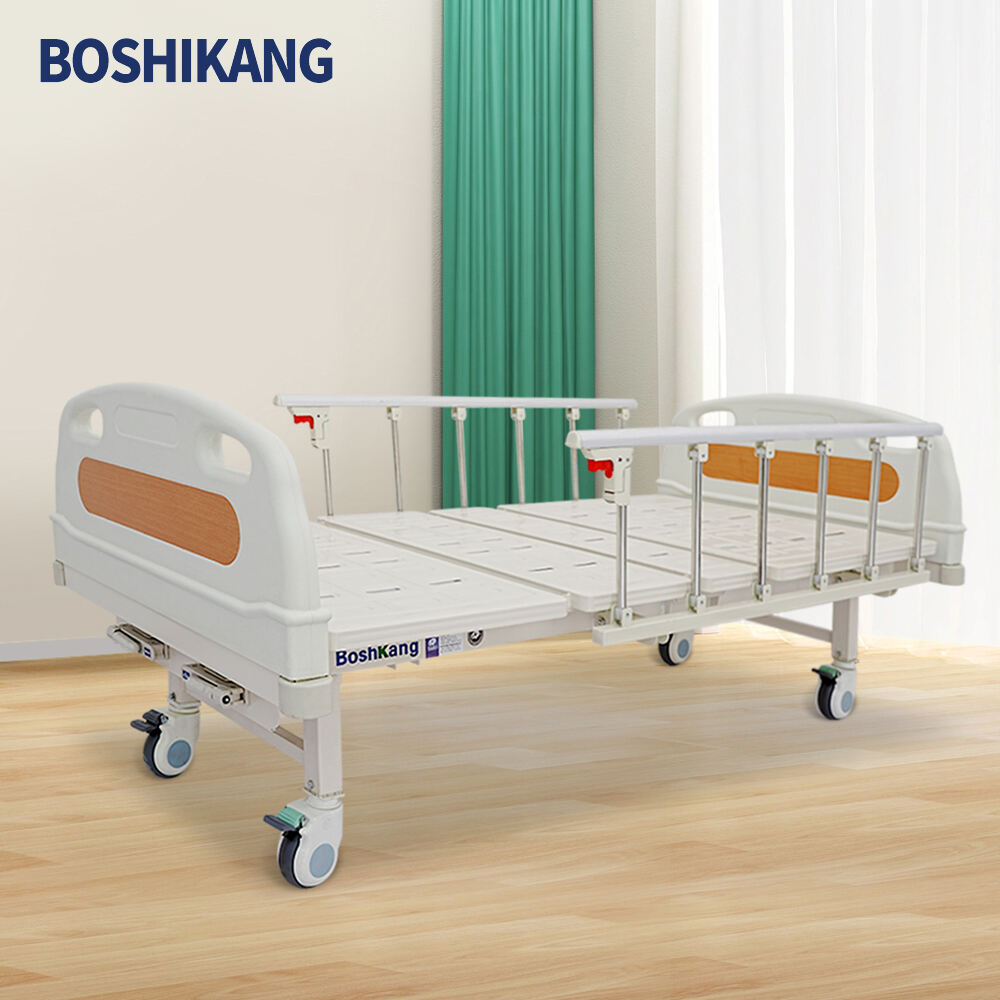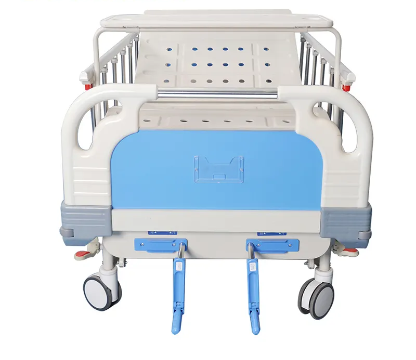Manual, Semi-Electric, and Fully Electric Nursing Beds
Manual Nursing Beds: Affordable and Simple
For healthcare facilities watching their bottom line, manual nursing beds present an affordable alternative since they depend on simple hand cranks or levers instead of expensive electric mechanisms. The price tag is lower too, plus there's no ongoing maintenance headaches either, making these beds work well for hospitals or clinics operating on tight budgets but still needing decent patient care equipment. Nurses can crank up or down the bed themselves when needed, which really helps when doing exams or administering treatments that require certain positioning. That basic design works great in smaller clinics or rural health centers where money is tight and staff need something reliable without all the fancy tech bells and whistles.
Semi-Electric Nursing Beds: Balanced Functionality
Semi electric nursing beds offer something in between fully manual hospital beds and completely automatic ones. They have electric motors that adjust the head and foot parts of the bed, which gives both patients and their caretakers much more freedom when it comes to positioning. The design cuts down on physical strain for staff members who would otherwise have to lift and adjust heavy beds manually, yet maintains enough manual controls so people can fine tune positions as needed. These hybrid models work really well in facilities where budgets matter but basic modern features are still important. Many long term care centers find they meet most patient requirements without breaking the bank on full blown smart beds.
Fully Electric Nursing Beds: Advanced Adjustability
Electric nursing beds take adjustability to another level thanks to their electronic controls for every possible bed position. Patients find this really helpful since they can move around more comfortably, and people who are able to manage some aspects of their own care appreciate having control over their environment. Many models come packed with useful extras too, like built-in scales that automatically measure weight without needing to lift someone, plus height adjustments that make it easier for nurses and other caregivers to do their jobs safely. That's why hospitals and long term care centers tend to prefer fully electric options when looking to improve both patient satisfaction and how efficiently staff can work throughout their shifts.
Specialty Nursing Beds for Critical Care Needs
Motor-Powered ICU Beds for Immobile Patients
ICU beds with motor power have become vital equipment in hospitals where patients need constant monitoring and specialized treatment. These modern beds can be adjusted rapidly, which makes them incredibly useful during surgeries or when doctors need to perform urgent tests on unstable patients. What sets them apart is their built-in tech that lets nurses move patients comfortably without much effort, something that matters a lot when dealing with fragile conditions. Most models now include alarm features too. For instance, if someone falls off the bed or starts showing signs of distress, the system will immediately notify the nursing team so they can respond fast. This kind of setup not only keeps patients safer but also helps medical staff work more efficiently under pressure.
Low Air Loss Beds for Burn and Skin Care
Low air loss beds have been created mainly to take better care of patients who suffer from sensitive skin issues, burn injuries, or any condition where managing moisture and relieving pressure is really important. The way these beds function involves creating steady airflow throughout the mattress surface. This airflow keeps the skin area around the patient relatively cool and dry, which goes a long way toward preventing those painful pressure sores we all know about. When used alongside standard nursing practices and special types of bedding materials, these particular beds become essential equipment for looking after high risk individuals over extended periods. Most healthcare facilities have strict rules about how to set up and maintain these beds properly because they do such an important job in preserving skin health and general well being for people who need extra protection against skin breakdown problems.
Bariatric Nursing Beds for Enhanced Weight Capacity
Bariatric nursing beds cater specifically to patients who are overweight or obese, providing the extra weight capacity and stability required for proper care. Most models can handle patients weighing around 1,000 pounds or even more, which means they won't break down under stress and keep everyone safer during treatments. As obesity rates continue climbing across the country, hospitals really need to stock up on these special beds. They allow facilities to serve a wider range of patients while meeting various medical needs that regular hospital beds just cant handle. For many clinics, investing in bariatric equipment isn't just good practice anymore it's becoming essential for day to day operations.

Adjustable Nursing Beds for Patient Comfort
Gatch Beds: Manual Positioning Without Electricity
Gatch beds work really well in situations where there's no electricity around or when folks just don't want to deal with electric equipment. The whole idea is pretty simple actually these beds let staff adjust them by hand through the frame itself, so patients can be positioned in all sorts of ways that make them more comfortable during their stay. Home healthcare setups especially appreciate this feature since money matters so much there. Caregivers get to tweak both ends of the bed themselves, whether someone needs to lie flat after surgery or sit up straighter to feel better overall. No wonder we still see these beds everywhere in hospitals and long term care facilities despite all the high tech alternatives out there. They keep working even when the lights go out.
Collapsible Nursing Beds for Space Efficiency
Collapsible nursing beds have become pretty much essential in today's patient care landscape, offering both function and the ability to move around easily. Designed specifically for storing away when not needed and transporting between locations, they work great in home healthcare situations or those makeshift clinics where every square foot counts. The way these beds fold up and come back together so quickly speaks volumes about how healthcare providers are thinking more about mobility lately. Even though they're built light enough to carry, there's still decent comfort built into them which matters a lot for both nurses doing rounds and patients spending time resting. No wonder we see more hospitals and care centers turning to these foldable options whenever flexibility becomes necessary but keeping proper support remains absolutely critical.
Choosing the Right Nursing Bed: Key Considerations
Matching Bed Type to Patient Mobility and Care Needs
Picking out the correct nursing bed matters a lot for how well patients recover and what kind of comfort they get during treatment. It really comes down to knowing how mobile someone is and what special care they need day to day. There are plenty of options available because every person's situation is different. Take motor powered ICU beds for instance. These work great when someone can barely move around on their own. They give extra support where needed most and take some pressure off already stretched thin hospital staff members. Getting input from both family members who help take care of the patient at home plus doctors and nurses actually makes all the difference. When everyone gets together to pick which bed works best based on how much movement ability remains plus any particular health issues present, then the overall level of care improves substantially over time.
Evaluating Space Constraints and Budget Requirements
Choosing the right nursing bed requires looking at both space issues and what the budget allows. Nursing beds come at different prices based on what features they have and how they work, so knowing what money is available helps facilities buy wisely. Facilities should check out the actual space where the bed will go to make sure it fits properly without getting in the way when staff need to move around. When care centers understand exactly what their budgets permit, they can focus on buying beds that strike a good balance between being affordable and actually working well for everyone involved. This approach ensures that both caregivers and residents get what they need from the equipment without breaking the bank.
Frequently Asked Questions
What is the difference between manual, semi-electric, and fully electric nursing beds?
Manual nursing beds require manual operation for adjustments, semi-electric beds allow electric adjustments of the head and foot sections, while fully electric beds offer complete electronic control over all bed positions.
Why might a facility choose a motor-powered ICU bed?
Motor-powered ICU beds are chosen for intensive support and quick adjustment capabilities, essential for patient stabilization and facilitating medical procedures in critical care settings.
What are low air loss beds used for?
Low air loss beds are used for patients with sensitive skin conditions or burns, providing pressure relief and maintaining skin integrity by preventing bedsores and keeping patients cool and dry.
Who should use bariatric nursing beds?
Bariatric nursing beds are designed for overweight or obese patients, offering reinforced construction and enhanced weight capacity for safe and comfortable care.


